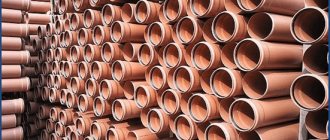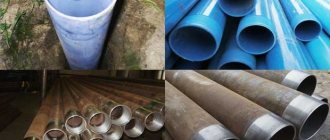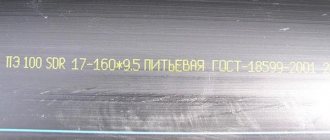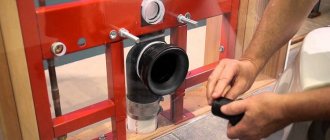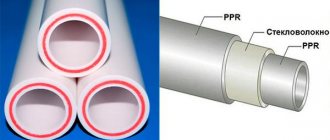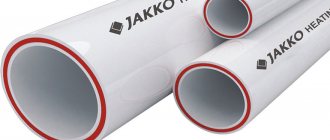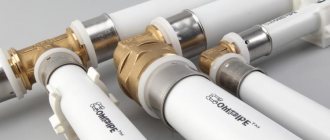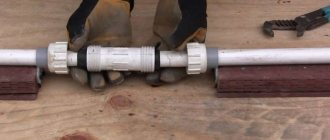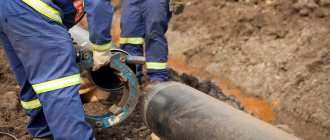Polymer materials have long strengthened their position in all areas of activity. For many decades they have been finding new niches of application due to their versatility. The first of these is polyvinyl chloride, a polymer whose annual consumption worldwide today is 30 million tons.
PVC pipes are in great demand and are produced in large volumes
What is uPVC
UPVC (in the international designation system PVC-U) is one of the three basic types of polyvinyl chloride. Its chemical formula is (C2H3Cl)n. In parentheses is the composition of a single polymer unit; the symbol n indicates an infinite number of repetitions during the polymerization of the material. In addition to uPVC, the basic types of polyvinyl chloride include chlorinated polymer (CPVC, or PVC-C) and a fairly large group of modified materials with special properties (PVC-M).
The answer to the question of how PVC differs from uPVC lies in the performance characteristics of these materials, which determine their scope of application. More information about this can be found in the regulatory documents regulating the production of different types of products. In relation to pipes, these are the following GOSTs:
- GOST 32413-2013 – free-flow pipes made of PVC-U for external drainage networks;
- GOST 32412-2013 – the same for internal sewerage networks;
- GOST R 51613-2000 – products made of PVC-U for pressure networks for supplying cold technical and drinking water;
- GOST R 52134-2003 – pressure pipes made of polymer materials for water supply and heating, including PVC-U and PVC-C.
The division of pipes into areas of application ensures their optimal use from a technical and financial point of view. This means that, depending on the intended purpose, you do not need to use products with clearly redundant characteristics to solve your problems.
How to calculate the casing diameter size
Before purchasing materials and constructing a water well, its size should be determined. Manufacturers offer a wide range of casing materials for wells.
The minimum diameter of products is 90 mm, the maximum is 225 mm. Wall thickness varies from 7 to 20 mm. For a domestic well, a common size is casing pipes 125 mm in diameter. Thick-walled products are used for installing deep artesian wells.
When choosing the size of a well, one should be guided by considerations of practicality. The dependence here is this: the more water is required daily, the more power the pump will use. When calculating the diameter of a well, the depth of its drilling also matters; the larger it is, the more powerful the pump will be required to lift it to the surface.
The more powerful the pump for pumping water, the larger its dimensions and the wider the well required to immerse it. Pumps with a flow of up to 8 mm have a casing diameter of up to 122 mm, which does not require a pipe larger than 125 mm.
Decoding the abbreviation
The abbreviation UPVC means “unplasticized polyvinyl chloride,” that is, a pure material of the homopolymer class. We have already given its chemical formula. To impart new properties, various additives are introduced into the material, with the help of which the following qualities are improved:
- thermal resistance;
- mechanical strength;
- resistance to aggressive environments;
- plastic;
- frost resistance, etc.
The listed characteristics, or rather their meanings, provide answers to the question of what is the difference between PVC and uPVC. Note that PVC-C polymer has wider ranges of values for most operational parameters compared to PVC-U. This applies to thermal resistance, mechanical strength and a number of other indicators.
Tips for choosing
Pipes are selected based on the characteristics of the future sewer main. Pay attention to the following parameters:
- Dimensions of external and internal sections.
- Wall thickness, strength classes and ring stiffness.
- Total pipeline length.
It is important to find a reliable supplier who will have a wide range of pipes from a reputable manufacturer. Fittings are purchased from the same materials and from the same manufacturer.
Estimated cost
The price for uPVC elbows is set per linear meter or pipe section and depends on the standard sizes and quantity of purchased products.
Thus, the cost of a 110×3 m HPVH pipe for external sewerage, with a wall thickness (3.2 mm) from the well-known Russian manufacturer Hemkor will be 546.33 rubles.
PVC and uPVC pipes: what is the difference
Consumers are most often interested in the differences between PVC and uPVC pipes from a practical point of view in order to choose the most suitable materials to solve their problems. However, among questions of this kind there are also those that relate to other aspects. For many, the differences between PVC and UPVC pipes are important in such parameters as:
- Material . Its properties are of decisive importance for the range of pipes in terms of diameter, wall thickness, methods of their installation, as well as for the operational characteristics of pipelines assembled from them.
- Life time . From this point of view, products made from PVC-U and PVC-C are equivalent. Their service life is at least 50 years, which is confirmed by existing cases of operation of utility networks from such pipes. Laboratory tests indicate that pipelines made from PVC and uPVC products can last up to 100 years.
- Difference in areas of application . In this case, use the instructions of regulatory documents (GOSTs) that regulate this issue. Restrictions on the use of pipes are determined by their operational properties, which are established for products of different sizes and methods of their installation.
- Characteristics of use . The fundamental difference between PVC and uPVC pipes is the temperature of the working environment for which they are designed. For uPVC products, the upper temperature limit of transported liquids in continuous operation is 45 °C. For PVC-C pipes, this indicator is 95 °C.
- Connection method . Pipes made of any grade of polyvinyl chloride are connected into a socket and couplings with O-rings or using glue. PVC, unlike polyethylene, is not welded.
- Appearance and color . In appearance, PVC and uPVC are colorless materials of varying degrees of transparency, and they are indistinguishable from each other. The color of the finished product is used for its visual identification and is achieved by introducing appropriate pigments into the materials. Gray color is recommended for internal sewer pipes, orange-brown tones for external sewer pipes, and dark gray for pressure pipes.
- Frost resistance . This indicator for PVC pipes is not critical, since they are not intended for open installation. However, uPVC is more resistant to low temperatures . PVC-C “freezes” earlier and becomes more brittle.
- Flammability . Polyvinyl chloride has a high combustion temperature, which can only be reached in a severe fire. Non-flammable grades of PVC are used in the production of electrical products, for which such temperatures can be reached without open flame. Taking into account the purpose of PVC pipes, they have no restrictions on their use in terms of fire safety requirements.
For uPVC products, the upper temperature limit of transported liquids in continuous operation is 45 °C. For PVC-C pipes, this indicator is 95 °C.
About other characteristics
External sewerage is increasingly made from PVC-U pipes. It is safe to say that in the near future this material will completely displace cast iron from the market. The advantage of the designs is obvious:
- light weight,
- not susceptible to chemical influences,
- average service life is 50 years.
Of course, uPVC pipes have their disadvantages. The operating temperature range is from -5 to +60° C. There is a high probability that the external sewage system will freeze (especially important for private houses). If the material melts, toxins are released into the atmosphere. PVC-U pipes are loved by rodents, so they often damage the products.
PVC-U pipe: GOST and marking features
The rules for labeling any product are established by the relevant regulatory documents. For example, the marking of non-pressure PVC-U pipes according to GOST 32413-2013 contains the following information in the following order:
- product material;
- outer diameter and pipe wall thickness in mm - for example, 250x4.9;
- indicator of the ratio of the diameter and wall thickness of the SDR product as an integer;
- ring stiffness indicator SN in kN/m2, indicating the permissible load when laying underground pipes;
- link to the regulatory document according to which the product is manufactured.
According to GOST R 51613-2000, the following product labeling is established:
- product material;
- SDR indicator;
- outer diameter and wall thickness of the pipe in mm;
- purpose - drinking or technical;
- link to the regulatory document.
For products in accordance with GOST R 52134-2003, a similar designation scheme is used, but after the third item of the list, the service class and nominal operating pressure of the pipes are added to the marking.
Tips on how to choose
The choice of pipes primarily depends on the purpose and operating conditions: for pressure or non-pressure systems, at depth or laying in basements, ducts, buildings.
Electrical, telephone or Internet networks are laid in pipes or corrugated pipes; often the communications are not sealed.
The second important factor is the working pressure in the water supply or soil pressure on free-flow networks. The choice of pipe design (smooth-walled, corrugated, double-layer corrugated, bell-shaped) depends on these factors. In addition, the temperature regime is taken into account - overheating of the ground in summer, freezing in winter.
The choice of ring stiffness class for a PVC-U sewer pipeline depends on the density and thickness of the soil layer above the communication. If the depth is greater or the sewerage system is located under a road or parking lot, strong corrugated pipes with a two-layer wall are used. Corrugation is also used for water pipes with high pressure or with a very massive screed over a heated floor system.
Estimated cost
The cost of the most common types of uPVC pipes in private construction - socket elements Ø 110 mm - is 110 rubles per meter pipe, 315 rubles for a three-meter pipe. Pressure bell-shaped round products with PN 1.6, 6 m long, cost from 1,750 rubles. A corrugated pipe for sewerage Ø 110 mm with SN6 costs from 170 rubles per meter.
Cost of uPVC communications
The cost of uPVC communications is low. Only thermistor fittings and collapsible couplings are relatively expensive. But when installing non-pressure sewer networks, they are rarely needed. When installing water pipes of small diameters for a private house, they are also not necessary; the usual bell-shaped structures are used.
Advantages of uPVC pipes
The growing popularity of uPVC and PVC pipes is due to such advantages of their use as:
- reliability;
- durability;
- ease of installation;
- a sharp reduction in operating costs for pipeline maintenance;
- pipes are completely harmless to humans and the environment.
Nowadays, polymer pipes are widely used in the modernization of utility networks and in new construction. They replace pipes made of steel, cast iron and other materials.
Types of pipes for well construction
Drilling a well is only part of the problem that must be solved in order to provide your summer cottage or garden plot with water coming from underground sources. To raise water to the surface, you need a pump, and first you need to lower a casing pipe into a hole drilled in the ground.
Construction of a well with casing pipe
As mentioned above, products made from metal, asbestos cement and PVC (UPVC) can be used. For use as casing metal and asbestos-cement pipes, lifting equipment is required, since they are heavy. In addition, rolled metal pipes are quite expensive, so their use is associated with significant financial costs.
Asbestos-cement products are more affordable, but they are inconvenient to install and are very susceptible to mechanical loads. When using asbestos-cement pipes as casing, situations often arise when they burst under the influence of external loads, which leads to erosion of the well and its subsequent clogging. Restoring it in this case is almost impossible, so the solution is new drilling. This naturally leads to additional financial costs.
Socket connection of uPVC pipes
PVC-U sewer pipes
Here we will answer the question of how PVC sewer pipes differ from uPVC sewer pipes. First of all, let us point out the incorrectness of the question. For the production of sewer pipes, only PVC-U is used. Other types of polyvinyl chloride have clearly redundant characteristics for this. If you can afford not to count money, then the sewer can be assembled from pressure pipes in accordance with GOST R 52134-2003. Moreover, a significant part of the range of pipes made of uPVC and PVC according to different GOST standards coincides in standard sizes.
Installation features
Depending on the method of connection, uPVC elements are made with or without a socket. For installation of the latter, welding is used. With the help of extensions at the ends of parts, fittings of various configurations, couplings and turns, sewer wiring is assembled. Adhesive technologies make it possible to increase the tightness of joints.
Installation using sockets is considered the simplest. Rubber gaskets are used to prevent leaks. Cold welding is used for pressure pipes; it is performed using chemical compounds. Adapter couplings reliably connect products made from dissimilar raw materials.
Purpose
Purpose of PVC-U sewerage systems:
- the products are used in the internal drainage system;
- during the construction of main communications;
- when draining household liquids;
- for rainwater;
- for drainage.
According to their purpose and area of application, plastic pipes are:
- having a bell and without bell;
- operating under pressure and non-pressure.
Bell-shaped structures are produced for gravity networks. In this case, the tightness of the joints is created by a rubber cuff, which is located inside the socket. And socketless structures are installed on pressure communications. They are fixed using adhesive joints, or fittings, which allow you to create bends, forks and turns.
Strength classes
When choosing a product, it is important to know what loads the sewer line can withstand under soil pressure and traffic. Based on this indicator, uPVC pipes are divided into ring stiffness class. It is denoted by the abbreviation SN and powers of 2. It is measured in kilonewtons per m2:
- SN2 – rigidity up to 2 kN/m2 (the main can be laid to a depth not exceeding 1 meter). Lightweight products are laid under the sidewalk, green area and in places where traffic loads are not expected.
- SN4 – up to 4 kN/m2 (placement depth up to 6 m). Medium-type products are chosen for installation in places where traffic is not so high.
- SN8 – up to 8 kN/m2 (placement depth up to 8 m). Heavy-duty products are chosen for installation in industrial areas and places with heavy traffic flow.
Corrugated bends, for example, belong to class SN8.
PVC-U pressure products are further subdivided according to the amount of internal pressure they can withstand. It is important to keep in mind that PN is not a pressure value, but rather a strength class for this parameter.
| Strength class | Nominal pressure (in MPa) |
| PN6 | 0,6 |
| PN10 | 1,0 |
| PN16 | 1,6 |
| PN20 | 2,0 |
How are products labeled?
Each building element must be marked with a special sign, which is applied to the outer surface of the pipe. The marking consists of combinations of letters and numbers in which the characteristics of the product are encoded.
Knowing the meanings of each sign, you can determine several important product parameters:
- Name;
- outer diameter (minimum);
- bell type.
The marking shows the thickness of the wall and indicates its purpose. Using the symbols you can also determine the date of manufacture and GOST number.
All of the above parameters are basic for labeling. If necessary, the manufacturer also provides additional information that every consumer should know. Symbols are applied to the surface of the pipe with a very heated tool. It is important to carry out this operation with extreme caution so as not to degrade the performance of the product. The distance between signs must be maintained within one meter.
Advantages and disadvantages
Now let’s look at the advantages and disadvantages of the products; this information is necessary for everyone who is going to purchase and use these pipes in household work.
uPVC pipes have many advantages:
- can be operated under large temperature differences;
- have a smooth inner surface;
- resistant to chemically active substances;
- have high strength;
- withstand heavy mechanical loads;
- have a long shelf life;
- made from environmentally friendly materials;
- They are light in weight, which makes them easy to transport and stack;
- have a low price.
But it is worth taking into account the disadvantages of PVC-U sewer pipes. The downside is that the temperature of the liquid being transported should be no more than +45ºC. Sometimes a short increase in temperature to +80ºC is acceptable. Violation of the temperature regime can shorten the service life of products.
Standard sizes
For laying street sewerage, PVC-U bends with a nominal outer cross-section of 110 mm or more are used.
In this case, its maximum values are for bends:
- Non-pressure single-layer according to GOST 32413-2013 – 1000 mm.
- Multilayer non-pressure according to GOST R 54475-2011 – 1200 mm.
- Pressure according to GOST 51613-2000 – up to 31.5 cm.
For internal wiring, the following sections are used:
- For bends from devices – 25-50mm.
- For a toilet – 110 mm.
- For risers – 110-160 mm.
The length is set by the manufacturer and ranges from one to 6 meters.
